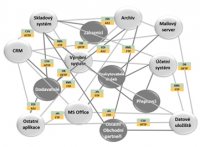Enterprise Application Integration EAI
Enterprise application integration (EAI)
 Current infrastructure of applications within individual companies often presents a list of many heterogeneous systems from different vendors providing different functions within the company or its organizational units, partners or service organizations (production systems, accounting, logistics, storage systems, CRM, archives, etc.), which often have their own specific communication interfaces and their mutual connectivity for optimal data sharing within the company is often very time consuming and costly.
Current infrastructure of applications within individual companies often presents a list of many heterogeneous systems from different vendors providing different functions within the company or its organizational units, partners or service organizations (production systems, accounting, logistics, storage systems, CRM, archives, etc.), which often have their own specific communication interfaces and their mutual connectivity for optimal data sharing within the company is often very time consuming and costly.
A special situation can occur in such an environment , that data is not automatically shared in all related systems or there is a need to manually enter into the system, even though they already exist in electronic form. If the systems are linked, any process change or system alteration means big costs.

In this communication spaghetti structure, even a central management system, data transfer management system or overall monitoring of communication between different systems cannot be ensured.
Business Integration Server (BIS6) of SEEBURGER offers a central platform middleware solutions to enterprise integration. BIS6 can not only connect all information systems within the company due to all the standard interfaces and options to customize the format of communication of different systems (IDOC, XML, TXT, CSV, DB), but also across organizational structures such as branches, subsidiaries, but also other partner organizations and authorities.
Information can be shared easily, safely and cost effectively across the organization, incl. partners, thanks to the implementation of the information system. Sharing information is controlled by defined processes (workflow) to provide unrestricted and secure data sharing among all applications or data sources within the company.
Another great benefit of the integration solution is to interconnect systems that are often located on different operating systems, use different database solutions and different programming languages and in some cases, become the systems that are no longer supported by vendors.
Benefits:
- Optimal shared business information according to defined requirements is achieved through integration solution that links all information systems.
- Time and money saved treatment of information systems are obtained through a standard interface integration system as a central communication system.
- Reduced administration costs, maintenance of individual systems due to a central solution that optimized link of systems.
- Increased data security and improved monitoring system of information exchange, which monitor data exchange between different systems and possibilities of secure communication and complete logging.